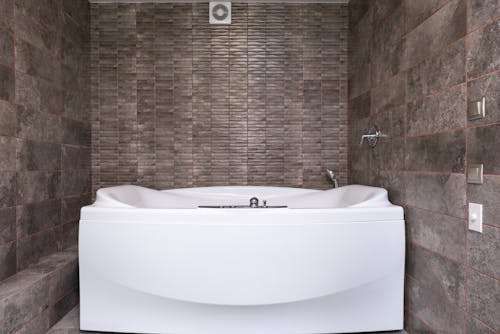Walk-in bathtubs are designed to provide a safe and accessible bathing experience, especially for individuals with mobility challenges or those seeking to age in place.
These specialized tubs feature a door that allows easy entry and exit, as well as various safety features like grab bars, non-slip surfaces, and built-in seating.
However, like any plumbing fixture, walk-in bathtubs can be susceptible to leaks, which can lead to water damage, mold growth, and even safety concerns.
Table of Contents
Understanding the Common Causes of Walk-In Bathtub Leaks

Walk-in bathtub leaks can occur due to a variety of reasons, including:
- Faulty Door Seals: The door seals on your walk-in bathtub are essential for preventing water from escaping the tub. Over time, these seals can become worn, cracked, or damaged, leading to leaks.
- Improper Installation: If your walk-in bathtub was not installed correctly, it can result in gaps or cracks that allow water to escape, causing leaks.
- Plumbing Issues: Problems with the plumbing connections, such as loose fittings or damaged pipes, can also contribute to walk-in bathtub leaks.
- Structural Integrity Issues: If the tub itself is not properly supported or has developed cracks or other structural issues, it can lead to leaks.
- Overflow and Drainage Problems: Blockages or malfunctions in the tub’s overflow and drainage systems can cause water to back up and leak out.
Importance of Addressing Walk-In Bathtub Leaks Promptly
Ignoring a walk-in bathtub leak can have serious consequences. Unaddressed leaks can lead to:
- Water Damage: Leaks can cause water damage to surrounding floors, walls, and even the substructure of your home, leading to costly repairs.
- Mold and Mildew Growth: Standing water and moisture can create an ideal environment for mold and mildew to thrive, which can pose health risks and further damage your home.
- Safety Concerns: Leaks can create slippery surfaces, increasing the risk of falls and accidents, especially for those with mobility issues.
It’s essential to address walk-in bathtub leaks as soon as they are detected to prevent these issues and ensure the continued safe and reliable use of your tub.
How to Identify a Walk-In Bathtub Leak

Recognizing the signs of a walk-in bathtub leak is the first step in addressing the problem. Some common indicators include:
- Visible Water Leakage: Look for water pooling around the base of the tub or dripping from the door or other areas.
- Damp or Discolored Flooring: Check for any dampness, staining, or warping of the flooring around the tub.
- Musty Odors: A persistent musty smell may indicate the presence of mold or mildew due to a leak.
- Unusual Noises: Listen for any gurgling or dripping sounds coming from the tub or surrounding plumbing.
If you suspect a leak, it’s important to investigate the issue promptly to prevent further damage.
DIY Solutions for Fixing Walk-In Bathtub Leaks
Depending on the cause of the leak, there are some DIY solutions you can try to address the problem:
- Inspect and Replace Door Seals: Carefully examine the door seals and replace any worn or damaged ones.
- Tighten Plumbing Connections: Check all the plumbing connections around the tub and tighten any loose fittings.
- Apply Sealant or Caulk: Use a high-quality silicone or acrylic sealant to fill any cracks or gaps around the tub or plumbing.
- Clean Overflow and Drainage: Remove any debris or blockages in the tub’s overflow and drainage systems.
However, it’s important to note that more complex issues, such as structural problems or extensive water damage, may require the expertise of a professional plumber or contractor.
When to Call a Professional for Walk-In Bathtub Leak Repairs
While some minor leaks can be addressed through DIY efforts, there are certain situations where it’s best to call in a professional for walk-in bathtub leak repairs:
- Persistent or Recurring Leaks: If the leak continues to reappear despite your DIY attempts, it may be indicative of a more serious underlying issue that requires professional diagnosis and repair.
- Extensive Water Damage: If the leak has caused significant water damage to your home, a professional can assess the extent of the damage and provide the necessary repairs.
- Structural or Plumbing Issues: If the leak is caused by problems with the tub’s structure or the underlying plumbing, a professional will have the expertise to identify and address the root cause.
- Safety Concerns: If the leak has created a safety hazard, such as a slippery floor or the risk of electrical issues, it’s important to have a professional address the problem.
By enlisting the help of a qualified professional, you can ensure that the leak is properly identified and resolved, protecting your home and ensuring the continued safe use of your walk-in bathtub.
Preventive Measures to Avoid Walk-In Bathtub Leaks
To help prevent walk-in bathtub leaks, consider implementing the following preventive measures:
- Regular Maintenance: Regularly inspect and maintain the door seals, plumbing connections, and other components of your walk-in bathtub to catch any issues before they lead to leaks.
- Proper Installation: Ensure that your walk-in bathtub is installed correctly by a licensed and experienced professional, following the manufacturer’s instructions.
- Avoid Overloading: Refrain from overloading your walk-in bathtub, as this can put additional stress on the tub’s structure and seals, leading to potential leaks.
- Immediate Leak Detection: Regularly check for any signs of leaks, such as water pooling or damp areas, and address them promptly to prevent further damage.
- Professional Inspections: Consider scheduling periodic professional inspections of your walk-in bathtub to identify any potential issues before they become major problems.
By taking these proactive steps, you can help extend the life of your walk-in bathtub and minimize the risk of costly leaks and water damage.
The Benefits of Regular Maintenance for Walk-In Bathtubs

Regularly maintaining your walk-in bathtub can provide numerous benefits, including:
- Leak Prevention: Routine inspections and maintenance can help identify and address potential leak issues before they cause significant damage.
- Improved Safety: Maintaining the tub’s safety features, such as grab bars and non-slip surfaces, can help prevent accidents and ensure a safe bathing experience.
- Longer Lifespan: Proper care and maintenance can help extend the overall lifespan of your walk-in bathtub, allowing you to enjoy it for many years to come.
- Increased Efficiency: Regular cleaning and maintenance can help keep your walk-in bathtub functioning at its best, ensuring optimal performance and water usage.
- Enhanced Aesthetic Appeal: Maintaining the appearance of your walk-in bathtub can help it continue to look its best and complement the overall design of your bathroom.
By prioritizing regular maintenance for your walk-in bathtub, you can enjoy a safer, more reliable, and longer-lasting bathing experience.
Walk-In Bathtub Leak Insurance Coverage
Walk-in bathtub leaks and following water damage may be protected by your renter’s or homeowner’s insurance policy. It’s critical to read over your coverage to learn the precise terms and conditions connected to water damage and plumbing leaks.
Some key things to consider when it comes to walk-in bathtub leak insurance coverage:
- Coverage Limits: Determine the maximum amount your policy will pay out for water damage and repairs related to a walk-in bathtub leak.
- Deductibles: Understand the deductible you’ll need to pay before your insurance coverage kicks in.
- Exclusions: Check for any exclusions in your policy that may limit or prevent coverage for walk-in bathtub leaks.
- Timely Reporting: Ensure that you report any leaks or water damage to your insurance provider as soon as possible to maximize the chances of a successful claim.
By understanding your insurance coverage, you can be better prepared to handle the financial implications of a walk-in bathtub leak and ensure that you receive the necessary support to address the issue and protect your home.
Conclusion
Although walk-in bathtubs are meant to make bathing safe and easy, they can leak, which can result in water damage, the growth of mold, and other safety issues. You can contribute to protecting the long-term reliability and security of your tub by being educated of the typical causes of leaks in walk-in bathtubs, putting preventive measures in place, and quickly correcting problems.
It’s important to keep in mind that engaging a skilled plumber or contractor can help you identify and fix any difficult or long-term leaks. Your walk-in bathtub can last for many years to come as a secure and comfortable place to bathe with proper cleaning and care.
Make an appointment for a consultation with an expert plumber if you’re worried about a possible leak in your walk-in bathtub or would just like more information about how to keep your tub in good working order. They are able to evaluate your specific situation and offer tailored advice to assist maintain the best possible condition for your walk-in bathtub.
How can I tell if my walk-in bathtub is leaking?
Some signs of a walk-in bathtub leak include visible water pooling around the base of the tub, damp or discolored flooring, musty odors, and unusual noises coming from the tub or plumbing.
What are the most common causes of walk-in bathtub leaks?
The most common causes of walk-in bathtub leaks include faulty door seals, improper installation, plumbing issues, structural integrity problems, and overflow and drainage malfunctions.
How can I fix a minor walk-in bathtub leak myself?
For minor leaks, you can try inspecting and replacing the door seals, tightening plumbing connections, applying sealant or caulk, and cleaning the overflow and drainage system. However, for more complex issues, it’s best to call a professional.
When should I call a professional for walk-in bathtub leak repairs?
You should call a professional if the leak is persistent or recurring, has caused extensive water damage, is related to structural or plumbing issues, or has created a safety hazard.
How can I prevent walk-in bathtub leaks?
To prevent walk-in bathtub leaks, you can implement preventive measures such as regular maintenance, proper installation, avoiding overloading the tub, immediate leak detection, and scheduling periodic professional inspections.

